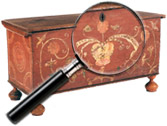|
|
Goofus Glass
Goofus Glass is a type of inexpensive American late 19th century/early 20th century pressed glass which has cold-painted decoration or highlighting.
The name “Goofus Glass” is generic to the type and it’s origin a matter of folklore. Some say that people thought the manufactures were trying to “Goof-us”, i.e. fool them with a substitute for more expensive glass. Others say that the tendency for the ware’s decoration to chip caused to people [...] Click here to continue reading.
Early American Cloth Dolls
The early American cloth dolls demonstrated the ingenuity and creativity of many settler families. When both money and material goods were scarce, it was not unusual for a mother to make a doll for her child by simply knotting whatever fabric scraps she could find.
If a corncob was available, it became the doll body. Fabric scraps were used for the arms and legs and clothing. As materials became more [...] Click here to continue reading.
Malacca Cane Shafts
A flexible type of bamboo from Southeast Asia, Malacca was the preferred, premium shaft for quality canes. It is most often associated with canes of English provenance, but was used throughout the world in fine dress canes, especially before 1830.
Eliphalet M. Brown Jr.
Eliphalet Brown had a long maritime career and was connected with the U.S. Navy almost constantly from 1855 to 1875, including service in the Civil War. Of particular note, Brown was attached to Commodore Perry’s expedition to Japan as daguerrotypist and artist.
Daniel Boone
Daniel Boone (1734 to 1820) is one of the most legendary figures in American history. He was born near Reading, Pennsylvania, but his family soon moved to North Carolina. After hearing stories of Kentucky, Boone set out for it in 1767 and lived there. He then helped develop the famed Wilderness Road as well as Boonesborough. He was captured by the Shawnees and he eventually escaped. In retribution, the Shawnees tried a [...] Click here to continue reading.
U.S. Invention Patent Models
Patent models are unique to a brief period of American history, when U.S. patent law required that all inventors submit a scale model of their invention in order to be granted a patent. With the recision of those laws in the late 1800s, models were no longer required, and the collections of the Patent Office’s 19th century models were placed in storage until budget constraints eventually forced the government to [...] Click here to continue reading.
Schoenhut Toy Company
Albert Schoenhut immigrated to the United States near the end of the American Civil War and began operations as a toy manufacturer in Philadelphia in 1872. Frequently linked to early composition Rolly Dollys and wooden toy pianos, the name Schoenhut is most synonymous with the wooden articulated Humpty Dumpty Circus figures made from 1903 to 1935.
Schoenhut’s first circus set was a simple ladder, chair and clown combination. Many different [...] Click here to continue reading.
The Crow Clockmakers of Delaware
Clockmakers surnamed Crow were active in the Wilmington, Delaware and Philadelphia areas as early as 1740 when George Crow was making and selling clocks and surveying instruments (through circa 1770). His son, George Crow Jr., is known to have continued this business in Wilmington, circa 1800.
Thomas Crow was making and selling clocks in Wilmington circa 1770 and had moved to Philadelphia circa 1790, and later removed to West [...] Click here to continue reading.
The Meaders Family of Folk Potters
The Meaders Pottery was started in 1892 by John M. Meaders in Mossy Creek, White County Georgia. Meaders built a log stucture and hired a potter to start the works and teach the trade to his six sons. All but one of the sons became potters, and one, Cheever, took over the original pottery in 1920. His wife Arie was a potter in her own right and specialized [...] Click here to continue reading.
San Ildefonso Pottery
Modern appreciation and collecting interest in Native American ceramics can be trace in large part to the artistry of Indian potters at the San Ildefonso Pueblo in New Mexico.
Foremost among these potters was Maria Martinez (1887 to 1980). She and her husband Julian rediscovered — and perfected — the method of creating the famous San Ildefonso blackware pottery. Her work is revered and collected worldwide. For many years Maria created [...] Click here to continue reading.
|
Recent Articles
- Charles Alfred Meurer – American Artist & Tromp L’Oeil Artist
- Sendak, Maurice – American Artist & Writer
- Godie, Lee – American Artist
- Davis, Vestie – American Artist
- Bartlett, Morton – American Artist
- Mackintosh, Dwight – American Artist
- Evans, Minnie Jones – African-American Artist
- Mumma, Ed (Mr. Eddy) – American Artist
- Nice, Don – American Artist
- Savitsky, John (Jack) – American Artist
- Gordon, Harold Theodore (Ted) – American Artist
- Dial, Thornton – African-American Artist
- Doyle Sam – American Artist
- Johnson, Lester Frederick – American Artist
- Finster, Howard – American Artist
|
|
